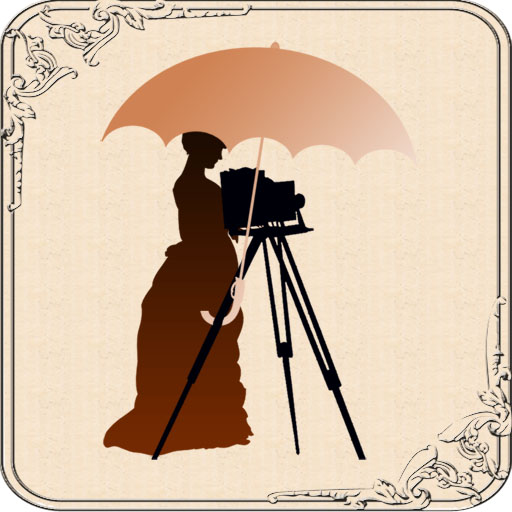Notes
Studio work samples
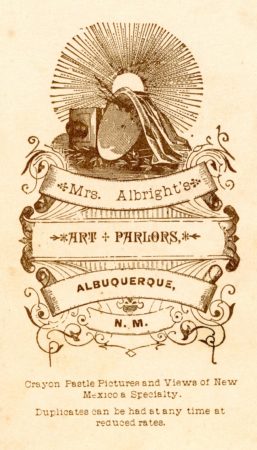
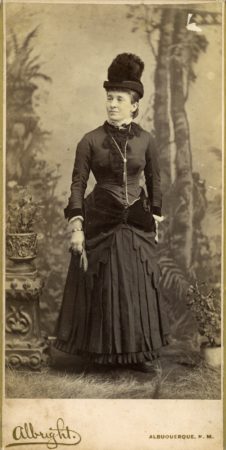
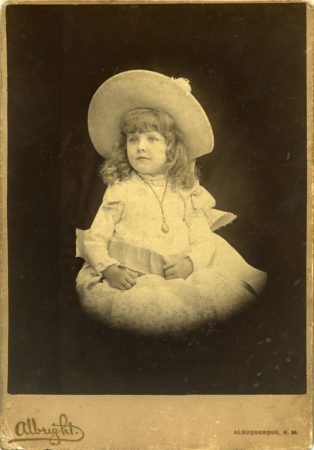
The Albuquerque museum has a collection online of Mrs. Albright’s work from her Art Parlor in Albuquerque, New Mexico. Click here to see their entire online collection of her work. They have some really beautiful examples from her studio, and also a couple of scenic (i.e. postcard-type) shots that she took as well.
My husband and I are always on the lookout, but so far we’ve only come across this one example of Mrs. Albright’s work in an antique store:

Advertising
Mrs. Albright knew the power of advertising to get customers for her photography gallery, right from the early days of her “Art Parlor” business in Kansas, and through the entirety of her 40 years in business, including running Albright’s Art Parlor for 30+ years in New Mexico. Here’s just a few samples over the years:




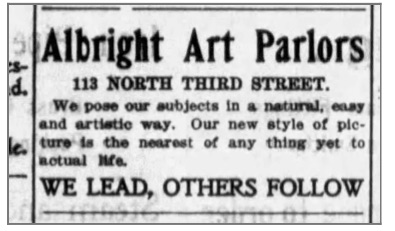
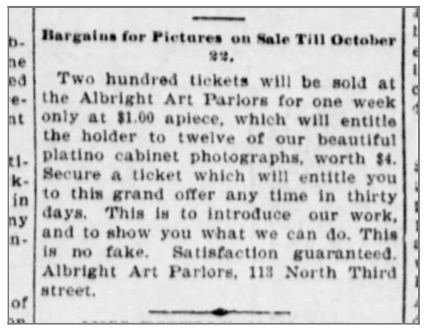
Yearbook
Mrs. Albright did a wide variety of photographic businesses, including not only her Art Parlors studio work, but also work for yearbooks. In 1898, she’s the official photographer for the first yearbook at the University of New Mexico, and in addition to talking all the photographs inside, she also takes out a large ad that’s published in the yearbook as well:
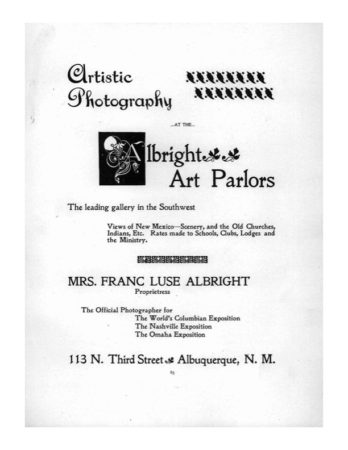
- Photos for the Expositions
As I discuss in this episode, Mrs. Albright was a master of providing photos for the big “Expositions” that were all the rage in the late 19th and early 20th century, both in the U.S. and around the world.
For the 1893 Columbian Exposition (aka the Chicago World’s Fair), Franc Luse Albright was a “lady manager”, and her photo appears in the booklet about the Lady Mangers.

Her favorite recipes for Caramel Cake and Mexican Enchiladas are also included in the souvenir recipe book, which includes an autograph by each of the Lady Managers who contributed the recipe. Here’s one of Mrs. Albright’s contribution, a recipe for a Caramel Cake:
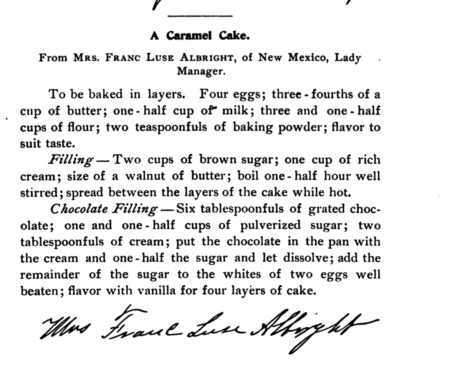
Note that the pubications from the 1893 Worlds Fair were download from the Internet Archive (archive.org), which is a great source of old books and other documents that have been scanned and made available free of charge online.
Lifeline

Recommended Links
- Albuquerque Museum’s online collection of Mrs. Albright’s work— Visit
- Ancestry.com (census records, city directories, and more; paid account required – Visit
- Family Search website has U.S. Federal Census and more; free account required – Visit
- Geneologybank.com has a selection of digitized newspapers from the United States; paid account required – Visit
- Mo Palmer’s blog and publications- Visit
- Newspapers.com has a selection of digitized newspapers from the United States; paid account required – Visit
- Newspaperarchives.com has a selection of digitized newspapers from the United States; paid account required – Visit
- Palace of the Governors – Photo Archives – Visit
- Peter Palmquist database at the Yale Beinecke Library – Visit
Transcript
You’re listening to Photographs, Pistols & Parasols.
Support for this project is provided by listeners like you. Visit my website at p3photographers “dot” net for ideas on how you, too, can become a supporter of the project.
*****
Welcome to Photographs, Pistols & Parasols, the podcast where we celebrate early women artisan photographers.
I’m your host, Lee McIntyre.
In today’s episode, we’re going to talk about the wonderful Mrs. Albright, the proprietress of Albright’s Art Parlors in Albuquerque, New Mexico.
For more information about any of the women discussed in today’s episode, visit my website at p3photographers.net.
That’s letter “p”, number “3”, photographers “dot” net.
*****
Hi everybody! Welcome back to Photographs, Pistols & Parasols. Thanks for checking it out. I know it’s been a while since the last episode but I’m really excited today to bring you the story of Mrs. Albright, a wonderful photographer from New Mexico whose career spanned four decades.
Now, Mrs. Albright started her life as a little girl named Francis Emma Luse. She was the ninth child of Sarah and Jonathan Luse, born in Pennsylvania in 1852. Poor Jonathan dies in 1851 before his youngest Francis Emma is born. Emma’s mother remarries and actually ultimately has another little girl by her second marriage, a little girl named Nettie Mills.
But unfortunately by 1870 Sarah is actually widowed yet again. And she’s moved to Laramie, Wyoming not too far from where one of her older daughters is living who is by this time married and living with her husband near Laramie. `So mother Sarah is running a boarding house in Laramie and living there with her little daughter Nettie and her daughter Emma.
Now Emma is about this time 18 years old and a couple years later, we actually discover her in Kansas, where she’s running a photography studio. I’m going to include on the website an ad from the October 1873 newspaper in Longton, Kansas, for “Miss Emma Luse’s gallery”. It’s a great little ad; it says it’s “a place to get photographs ambrotypes and tintypes or any other style of picture that may be desired.”
It’s really kind of a cute little ad, and the reason I’m going to include it in the episode notes is you can compare it to an ad that appears a few months later in January, 1874 – because that ad is just about identical, except instead of being “Miss Emma Luse’s Gallery”, t’s now “Mrs. Albright’s Gallery”. You see, Emma Luse married J.G. Albright in December of 1873. It’s really kind of funny how she just reuses the same text of the ad, and it’s the same location for the gallery, but now it’s Mrs. Albright’s Gallery.
Now in the period between 1874 and 1880, Mrs Albright is running that gallery in various places in Kansas. In 1873, there was a big panic in Kansas , an economic crash, and that may be the reason that Emma and her husband, J.G. Albright move from Longton to Howard, Kansas.
Mrs. Albright sets up her gallery in Howard just like she had it in Longton. And at that time we find notices in the paper not just for Mrs. Albright’s photographic gallery, but also for her millinery gallery in the same place; in other words, she’s doing both photography and millinery work there in Howard, Kansas circa 1877.
So, it’s just interesting to find a photographer also running a millinery business.
What’s interesting is that the ad that I saw in 1877 for the millinery business says that what she will also make is “hair switches “.
Now, I’d never heard that term “hair switch”, but that was the 1877 term for what we would in modern times call a “hair extension.”
The ad in the newspaper says that she will pay the highest cash price for human hair in order to make those hair switches.
By 1880 J. G. buys an interest in a newspaper in Santa Fe, New Mexico and becomes a newspaperman there, and Mrs. Albright moves her gallery to Santa Fe operating “Mrs. Albright’s Art Parlors”, a name that she would continue to use even after moving her business from Santa Fe to Albuquerque, New Mexico in the mid-1880s.
Mrs. Albright’s Art Parlors are known for doing all kinds of work. So she does the studio photographs of children, couples, all your standard artisan photography of the day. She’s also taking pictures of buildings in town. She’s taking pictures of scenes in town. She’s taking pictures of the legislators . New Mexico is a very vibrant territory at this point. It won’t become a state until 1912, but there’s still a lot going on in New Mexico, and Mrs. Albright is taking pictures of, as I said, all kinds of people.
Her fame becomes renowned in the area and even as she weathers having several competitors there in Albuquerque in the 1880s, she is really the most prominent photographer that you find in the newspapers and mentioned in the social notices, I mean, she’s prominent society as well.
Her husband is one of the newspaper publishers running the paper for a number of years. Interestingly, his brother also is a newspaper man running a different newspaper in that same area, and sort of a fun fact: shortly after the Albright’s moved to New Mexico., J. G’s brother George marries Nettie Mills. Nettie Mills is Mrs. Albright’s younger sister. So it’s interesting that the two sisters marry the two brothers.
J.G. has a number of different ventures, and he acquires a number of different nicknames. At one point he acquires the nickname of “Gassy Jack”. He later is referred to as the “Alfalfa King” when his business venture changes; and then at some point in the 1890s, he acquires the title of Colonel. So starting the 1890s he’s consistently referred to as Colonel Albright, although I’m not exactly certain why.
Probably this a good time to point out. It’s not just Colonel Albright’s name that causes a problem of terms of knowing how to refer to him, but also the case for Mrs. Albright.
Now I referred to hern earlier as Emma, because in the earliest notices in the newspaper for her photography, she’s either Miss Emma Luse or Mrs. Emma Albright. At some point it switches, and she’s more consistently, for a period of time, either Mrs. J.G. Albright or just simply Mrs. Albright.
Now her first name was Francis. And there’s only one notice – actually that notice of her marriage in 1873 – where she’s not referred to as Emma as she is in every other notice at that time, but as Franc – F R A N C – like Francis, but without the “”is at the end.
But that name “Franc” actually becomes the name that she’s more well-known as, because around 1891 we start to see in the newspaper ads , she’s consistently signing stuff as Mrs. Franc L Albright or Mrs. Franc Luse Albright.
And it’s really quite striking , because as I said before that point, she was usually using her husband’s initials – Mrs. J.G.. Alright – but she’s establishing herself as a very successful businesswoman. She’s been running this Art Parlor now for many years by 1892, and she has received a lot of renowned for her work.
But in 1882, this is when she actually becomes very involved with what was later the 1893 Columbian Exposition or the World’s Fair in Chicago in 1893.
Mrs. Albright is appointed as one of what’s called the lady managers of the fair responsible for the Women’s Pavilion and [Mrs. Albright is] also [responsible] for things related to New Mexico. Mrs. Albright is consistently writing like a little column about the goings-on about the group of lady managers in the lead-up to the fair .
And with kind of fun is that it not only is she organizing photographs and other handicrafts and things like that, she’s also involved in work to raise money to help women get to the fair. That includes a recipe book where all the lady managers of the fair contributed their favorite recipes into this little recipe book to be sold – I mean, you still find that as something that groups today do, like in churches and other organizations. So it’s just fun to find this recipe book by the lady managers of the World’s Fair.
They also have pictures of all the lady managers and so we have a nice picture of Mrs Albright circa 1890 . Now this organizing things for this kind of fair or exposition, this kind of extravaganza, is something that becomes M rs. Albright specialty seemingly, because you find notices in the newspaper that she is very prominent doing that kind of thing consistently.
She does it not only for the Columbian Exposition in 1893, but she also does it for the territorial fairs in New Mexico over the years in the 1890s and 1900s. She also does it for similar functions in Nebraska and in Tennessee, and she actually calls that out in her advertising circa 1898.
Actually, I’m going to include on the episode notes one of the ads she has circa 1898 which appears in the first year book for the University of New Mexico. Not only is she advertising in that year book, she’s also the official photographer for the University of New Mexico’s first official yearbook [in 1898] .
S he continues to do this consistently in the early nineteen hundreds. She was actually organizing her last one in 1911, which was just a year before her death.
Another Expedition that I want to call out is the one in 1900 in Paris. This was another big achievement for Mrs. Albright because she’s appointed to do the New Mexican Pavilion in the Paris Exposition. For that pavilion, she provides photos of new Mexican schools.
There’s an interesting set of ads in the newspaper and the late 1890s in New Mexico advertising for “pretty babies” because s he’s at that point planning to do an exhibition of pretty babies from New Mexico for the Paris Exposition. At some point or other her plans change, because what she actually exhibits there are photos of school buildings. She wins an award for her work and is also paid for work.
So doing these expositions is to me one of the most remarkable things about Mrs. Albright because she’s running the studio and building her business and her reputation as a portrait photographer in the studio there in the “Art parlor” in Albuquerque, but she’s also then got this wide range of contacts and connections throughout the United States and Europe who celebrate and appreciate her work.
As a side note, I forgot to mention circa 1898 there’s also an interesting notice in the newspaper that William Jennings Bryan was giving a speech somewhere, and he makes a detour to go specifically to Mrs. Albright’s Art Parlor to have his portrait taken by Mrs. Albright. . She was that well-known.
All right, so we have made it up to basically 1900 in Paris and that Exposition and she goes over for the exposition of course, but she also has other connections to Paris around 1900.
I don’t think I mentioned but when the Albrights move from Kansas to Santa Fe, they take along their little daughter who is referred to at that point as Dolly. But Dolly was actually christened Claudia Albright and Claudia grows up to be an opera singer. Quite a well-known opera singer, except she also changes her first name ,so professionally and personally she is known as an adult as Claude Albright.
So it’s again we’ve got Franc Albright, who is the mother; Claude Albright who was the daughter; neither one of whom have traditionally female names, which makes it a little bit of a challenge to do the research when you’re looking for early women photographers.
As a side note, I should mention also that I will bring you in the future the story of another early one photographer there in Albuquerque in the late 1800s. And that’s a woman who was a competitor of Mrs. Albright. Who actually started working for Mrs. Albright as a young woman; then, as a young single woman, goes out on her own, then joins forces with and ultimately marries a male photographer in town and together that woman and her husband run the Cobb Studio, which is probably the most well-known Albuquerque Studio from the late 1800s and early 1900s.
But the woman who ran that studio – the woman photographer who worked for Mrs. Albright – was a woman named Eddie Ross Cobb.
So again when I ran across these women a few years ago. I was just struck not only by their careers, but also about the fact that their names made it really hard to track them as women photographers.
But getting back to Claude .. Mrs. Albright is particularly supportive of Claude’s opera career. You can see that through the notices: e.g. she sending Claude here, there ,and everywhere.
Ultimately in Paris, Claude becomes very good and stars touring the continent ..start storing in England ..she comes back to the U.S. And tours around the U.S.
And there are always notices in the newspaper that Mrs. Albright is often on her way to or coming from accompanying her daughter on some tour. But through it all the Albright art parlor is still going strong even as she starts to travel more and more with Claude.
Mrs. Albright will put a notice in the paper periodically saying hey, I’m back in town, come get your picture taken while I’m here.
So she’s still running that business, even though she isn’t doing it quite as regularly according to the notices in the newspaper.
But Claude’s career really takes off.
She is ultimately described as the Nightingale of New Mexico and there are ads in the newspaper when she’s giving a special performance in Albuquerque ..when she’s sort of back visiting her mother ..Or there’s even ads in a newspaper for later on when she does recordings of some of her more famous arias. Unfortunately my husband and I haven’t been able to track down any examples of those.
There are also other notices which are kind of remarkable, but then maybe not so remarkable knowing how prominent Mrs. Albright really was there in Albuquerque in the early 1900s. A t one point there’s a notice that Claude is back visiting her mother for the summer and then unfortunately, a couple of weeks later, there’s a fire in the studio and there’s a big write-up that says that luckily a dog barking alerted the mother and daughter to the fire in the studio, or else they might not have gotten out in time.
Then there’s another thing that really has nothing to with Claude, but apparently Mrs. Albright will take nephews with her to go visit Claude when Claude is performing somewhere, and then also invite nephews to come and stay with her.
Unfortunately around 1910 there’s a big mention in the newspaper that $1000 of Mrs. Albright’s jewels were stolen. But then it turns out a couple of days later that it was actually her 12-year-old nephew, who was visiting, who was the culprit. he confesses; he’s contrite; he returns the jewels and Mrs. Albright declines to press charges.
Now J.G., or as we c all him, the Colonel – he’s still around but he’s off doing other business ventures at this point in the early 1900’s;
I think the Albrights are still married, but it’s usually the case that when there’s a notice in the newspaper about Claude coming back to Albuquerque to visit, she’s coming to visit her mother. And her mother is living in the same building with the studio.
It’s a building that her mother actually owned, and so it’s just interesting to speculate that maybe you know, the Albrights had been together so long that they were just leading separate Lives somehow, coming back together occasionally.
But there’s just not a lot of mention of them doing a lot together. One of the exceptions is that they are going to perform together; apparently both. Mr. And Mrs. Albright sang.
And so in late February of nineteen twelve, it’s planned that Mrs. Albright and her husband were supposed to be singing together at a fundraising event.
But unfortunately, before that can happen, tragedy strikes on the morning of February 10, 1912.
That’s when the young servant girl who was employed by Mrs. Albright finds Mrs. Albright dead in her bed. Apparently, Mrs. Albright suffered a heart attack and died in her sleep at the age of only 60 in 1912.
So that’s the end of Mrs. Albright’s 40-year career in photography.
But I do have a little postscript for what happened after Mrs. Albright died.
When Mrs Albright passes away in February of 1912 , the Colonel was away from home, and Claude Albright was traveling in Europe performing. Telegrams are sent to bring Claude back for the funeral and to bring the colonel back to Albuquerque.
Mrs. Albright’s death is announced in very large headlines announcing her death. The colonel is described in the newspaper accounts as being prostrate with grief at the death of his wife. A lot of events in town are actually canceled in honor of Mrs. Albright and the fact that she’s suddenly passed away,
But that’s not the postscript that I really wanted to tell you …
When Claude comes back, they have the funeral and Claude sticks around Albuquerque and the Colonel files to be administrator of Mrs.
Albright’s estate because Mrs. Albright had that studio, and the studio building, and of course a very successful business, and unfortunately, no will is found, so Mrs. Albright dies intestate.
Fast forward just a little bit and we find Claude Albright filing suit against her father the colonel because Claude claims that the studio building that Mrs. Albright owned was owned in Mrs. Albright’s name alone, and was not community property. Claude further says that her mother had intended that property to go to her as her inheritance, that it wasn’t supposed to go to the Colonel.
The case drags on; again, it gets pretty prominent coverage of the newspaper and Claude’s Aunt Nettie – that’s the wife of the newspaper man who is the Colonel’s brother – well Aunt Nettie testifies in support of her niece, saying that yes, Franc Albright really did intend that studio to go to Claude.
But ultimately the court rules with the Colonel. In December of 1914 the court awards that property to Colonel Albright saying that it was in fact community property and therefore he gets it.
The property in question is according to newspaper account worth $1,100 in 1914. Now Claude will ultimately appeal that case all the way up to the New Mexico Supreme Court. Unfortunately, she loses there in the end in 1916. So Colonel Albert gets the $1,100 property.
You might think that this would have driven a wedge between father and daughter sort of permanently since Claude was pursuing that all through the courts, but in fact in the end the Colonel announces Claude’s wedding in 1917. So maybe all was forgiven.
But maybe there are other factors in play.
It’s interesting to note that when the judgment came down in that first court case in December of 1914, there’s a note in the newspaper that Claude herself is actually off in Texas because she’s dealing with the “valuable property” that she’s just inherited from an aunt who died in 1914.
Well that aunt not only left that property but she died leaving a literal fortune to be divided up among any of her surviving brothers and sisters and their surviving descendants. Franc, of course, had passed away in 1912, so her part of the inheritance passed to Claude as her only descendant. Claude’s share of that estate from her aunt was $75,000 dollars in 1914. That’s the equivalent of $1.8 million dollars in 2019.
Claude did pursue the case to 1916 against her father. Maybe it was more the principle of the thing than the money. But maybe she didn’t mind losing the $1100 from her mother’s property since she inherited far, far more from her aunt.
So who was that aunt,then, that had all this money. I mean the Albright’s were prominent in society, but they were nowhere near that wealthy.
As I said, Franc Albright’s property was only worth $1,100. Her entire estate was only worth 15,000 according to the newspapers.
But Franc Albright’s sister’s estate was worth half a million dollars. Her sister’s name was Sarah Luse Larimer .
If you think back to the beginning of the story today when I mentioned that Emma Luse and her little sister Nettie and their widowed mother Sarah were all living in Laramie, Wyoming. Well, they were living in Laramie, Wyoming presumably because they were near one of Mrs. Albright’s older siblings: her sister Sarah, who’s married name was Sarah Larimer.
[Turns out that] Mrs. Sarah Larimer was running a photography studio there.
I think it’s likely that Emma actually learned photography from her older sister Sarah, probably there in Laramie, but I don’t know that for sure.
But I do know that Emma Luse did learn photography around that time, because by the time she’s opening up her studio in Kansas a couple of years later, she says that she’s already learned photography somewhere else. So it’s plausible that her sister Sarah taught her how to do photography.
Sarah Larimer was a successful photographer in her own right in Wyoming and Kansas. She seems to have been very close to her sister Franc and there are many, many notices of visits between the sisters over the decades between 1870 and 1912. In all of those notices, Mrs. Larimer is usually described not only as a photographer, but also as an authoress.
You see, she wrote one book that was published around 1870.
The reason she wrote that book .. what happened after she wrote that book ..and also more about her successful photography career. …well, the story of Sarah Luse Larimer, authoress and photographer, will be the subject of the next episode here at Photographs, Pistols & Parasols.
*****
I really want to thank a lot of people today from the New Mexico museums. First there’s the Albuquerque Museum in Albuquerque, New Mexico, which has a marvelous archive of samples of works from the Albright studio.
The Albuquerque Museum also has a wonderful exhibit about the Cobb Studio, the one run by Eddie Cobb and her husband.
I’m going to include some of the Albright Studio cabinet cards that are from the Albuquerque Museum in the episode notes.
My husband Chris and I also ran across a sample of Mrs. Albright’s work, and so I’m going to post the one that my husband and I have as well.
I want to thank Glenn Frey, who was the curator of photographs at the Albuquerque Museum when I stopped in there a couple of years ago and gave my husband and I a tour around the museum, along with an introduction to their photographic archive and materials.
I also want to say a huge thank you to Mo Palmer, a historian and former curator at the Albuquerque Museum. Mo Palmer has worked documenting the history of Albuquerque, including work on several documentaries as well as a book about the Albuquerque then and now.
She also gives talks from time to time on the early women photographers in ABQ and Santa Fe, particularly Franc Albright, Eddie Cobb, and Alabama Milner. Mo is a font of knowledge about these women- I really appreciate about how she’s been very generous she’s been with her time and sharing her research.
I have some other research lines of inquiry open as well to continue diving into France Luse Albright’s remarkable career. Be sure to check on the Photographs, Pistols & Parasols Facebook page for any updates on that – and look for a Part 2 about Mrs. Albright and her fellow women photographers in 19th century New Mexico coming sometime in 2020.
I also want to thank the people from the Palace of Governors Photo Archive, which is in Santa Fe. Now. That’s actually the first place I ran across any of these women photographers from New Mexico, several years ago when my husband and I were passing through town. We’ve been back there just recently, and I want to thank again Hannah Abelbeck, the photo imaging specialist at the photo archives at the Palace of Governors, for all of her help and figuring out how to find some of the information about these women.
I also really want to thank my husband Chris Culy as always, for all of his work doing research because it was thanks to him that we actually uncovered a lot of different pieces of information including all of the information about Claude Albright’s lawsuit against her father.
And finally, I have sort of a special shout out to the people at the Ballard Consignment Shop here in Seattle. Special thanks to Robin and David; Robin for the new microphone table that he had consigned to that shop and was there the day that I bought it. I really want to thank him because I’m using it right now to record the podcast.
Well, that’s it for today. i really want to thank you for stopping by particularly after such a long gap in the episodes here on Photographs Pistols & Parasols.
For the next little while, due to a bunch of events that I have coming up, I’m going to just do a podcast once a month instead of twice.
So look for new episodes on the first of the month going forward at least for the next few months while I sort of few things out.
I’ll be in touch on the Facebook page with some updates about my comings and goings and a couple of lectures that I’ll be doing in the upcoming months.
As always you can find all of the information about today’s photos and ads and anything else related to Mrs. Albright and other women that I mentioned on the podcast on the website at p3photographers.net. That’s letter “p” number “3” photographers “.” net.
If you have any questions about Mrs. Albright, or anyone else I’ve mentioned here on the podcast, send an email to podcast “at” p3photographers.net
And check out the Facebook page at facebook.com/p3photographers.
As I said the next episode we’ll be covering Sarah Luse Larimer .
Really, not only her photography and her authorship of a book, but some other things that led to that book, are really going to make for a compelling story on the next episode. You won’t want to miss it. .
Until then, I’m Lee McIntyre and this is Photographs, Pistols & Parasols.
